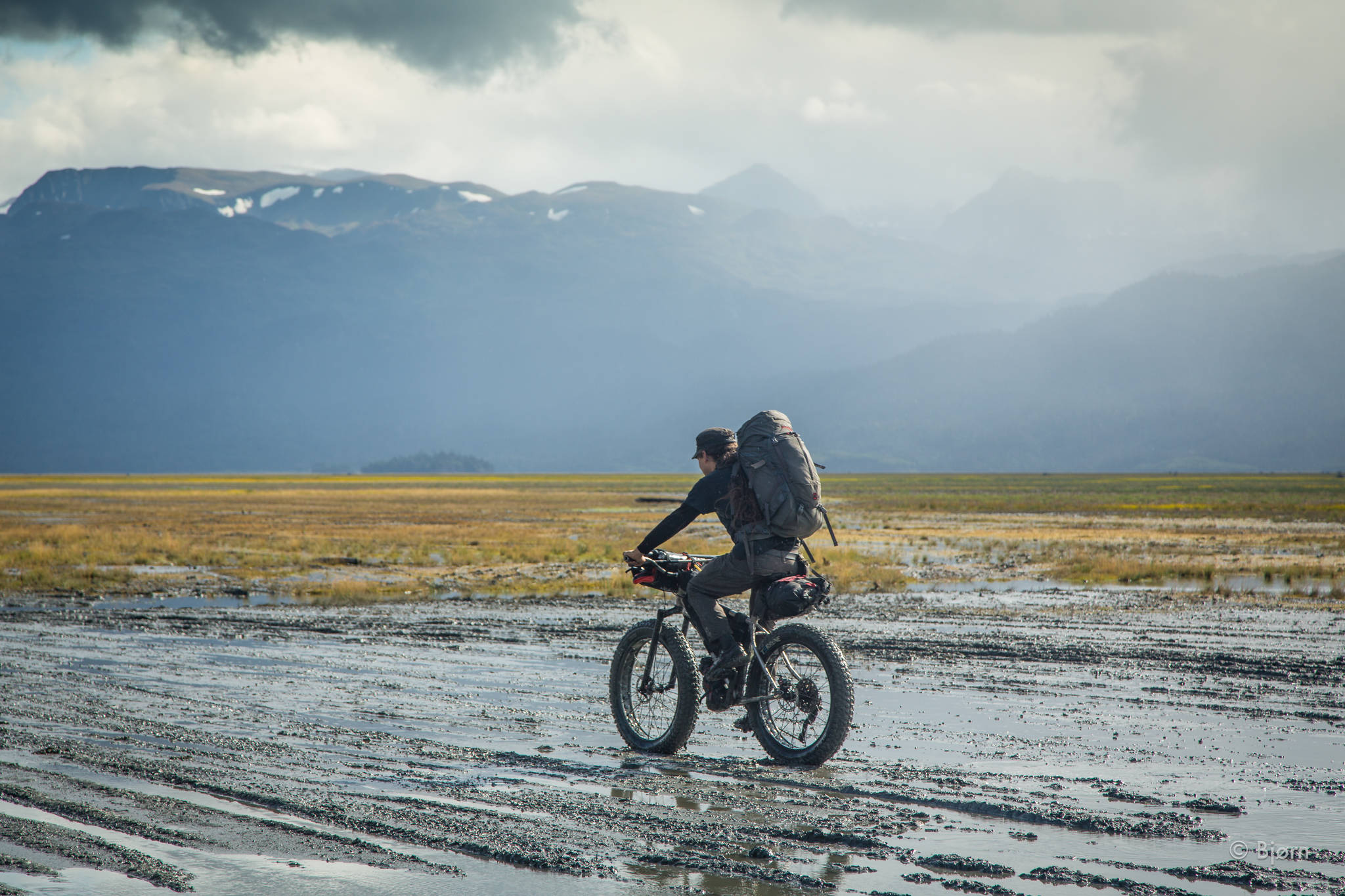The idea behind any wilderness bicycling adventure is to ride as much as possible. This often means shifting into the lowest gear and focusing every ounce of attention to make it over watermelon sized rocks, deadfall trees, through knee-deep creeks, and other assorted obstacles one is bound to encounter in the backcountry. For me, the challenge is a rewarding and personal one, but when riding with good-natured friends any “dab,” which is jokingly called out anytime a foot touches the ground, is to be avoided.
Labor Day Monday, I along with seven other backcountry cycling friends, found ourselves at the head of Kachemak Bay. We were on a fat-bike and packraft trip from Homer to Halibut Cove Lagoon, on a route we have taken to calling The Adventure Trail.
Weeks of rain had turned the Fox River Flats into a greasy mud bath. All eight of us slipped and slid; our tires packed with silt and shoes soaked through. The Adventure Trail was living up to its name and through belly laughs “dab!” was called out as one-by-one folks picked their muddy butts and bikes up off the slippery shore.
In 2006, the cycling industry took a leap of faith. Since the mid 1980s, Alaskan cyclists have been attempting wilderness cycling routes, but standard mountain bikes are often not up to the challenge. It became apparent that wider wheels and tires are required in order to avoid long stretches of bike pushing. From the pressings of a handful of creative Alaskan adventurers the modern fat-bike was born.
The mid 1980s also saw the birth of the inflatable, one-person packraft. These sub-six-pound watercrafts—propelled with a break-apart kayak paddle—were first used in adventure races and long wilderness treks in Alaska. In a state with few roads, trails or bridges, the fat-bike and packraft open the door for uniquely Alaskan adventure, which is now being applied worldwide.
Alaska has exported the fat-bike and the packraft. Around the world, people look to our state for inspiration and advice. For many, Alaska has become a Holy Grail—the top of the bucket-list destination for a fat-bike and packraft experience of their own.
As our team sloshed and slipped through the mud at the head of the bay, we decided to paddle our packrafts at the first opportunity. In the early afternoon sun, we inflated our rafts, removed wheels from the bikes and strapped everything down. Our group paddled out the Fox River then onward to the far-shore of Kachemak Bay.
I first rode and paddled the Adventure Trail—from Homer to Seldovia— in 2008, not long after moving to Homer from Moose Pass. For anyone who stares at maps and imagines wilderness routes with a bike, this trip sticks out like a sore thumb. It has some of everything: world-class beaches, single-track trails, rivers to run, open water paddling, a healthy dose of on-the-spot route finding and the convenience of an inexpensive water taxi ride home. Little did I realize at the time that I was in violation.
For a place that boasts world-class fat-biking terrain, Homer is currently a less than ideal place to own or ride one. To the north, the 1.92-million-acre Kenai Wildlife Refuge offers recreation opportunities for hunters, equestrians, motorized recreation and other users, but bicycles are not allowed. To the south, the 400,000-acre Kachemak Bay State Park and Wilderness Park, also does not allow any non-motorized, wheeled devices within their boundaries. While the beaches and winter trails of the Caribou Hills offer great day rides, the adventure cyclist is hemmed in when it comes to creative route finding in the Homer area.
Our work-around for this recent trip was a one-time, $100 permit to pass through the Kachemak Bay State Park. It is, however, the goal and aspiration of Homer Cycling Club—whose mission is to improve cycling conditions in the Homer area—to see these baseless bicycle prohibitions removed. The contributions that the cycling club has made to the Diamond Creek Rec Site are evidence of the positive contributions that cyclists bring to public lands.
Brilliant shafts of evening sunlight poked through the clouds as our group closed out our second day. We rode the Aurora Lagoon beach in silence, admiring the beautiful sky, which exploded above Homer—each of us choosing our own line. Heavy rain was in the forecast but moods soared that evening as we cooked dinner, reflected on the variety filled day and prepared camp.
The following morning, one short and final paddle remained, across Mallard Bay, before reaching Grewingk Valley. The predicted rain came but traction on the gravel trails, with our oversized tires was exceptional. Several of us carried folding handsaws and as we rode we attempted to clear some of the deadfall trees that littered the Humpy Creek Trail.
The Adventure Trail can end in Seldovia or, if a party is so inclined, continue on to Red Mountain or even the Gulf Coast along the derelict Rocky River Road. Due to time constraints, our party opted out in Halibut Cove Lagoon.
Riding a bike in the backcountry is not for everyone. This form of travel is prohibitively cumbersome for many cyclists and requires too much coordination and focus for most hikers. In order for a wilderness bicycling route to make sense there must be a high percentage of the terrain that is actually rideable. Our group and the Adventure Trail met the ascribed criteria. For those self-reliant enough to embrace it, the rewards of wilderness travel by bicycle are immense, and The Adventure Trail is an ideal place to make these discoveries.
For others hoping to experience this challenging and rewarding route I hope our trip helps pave the way…without the pavement.


